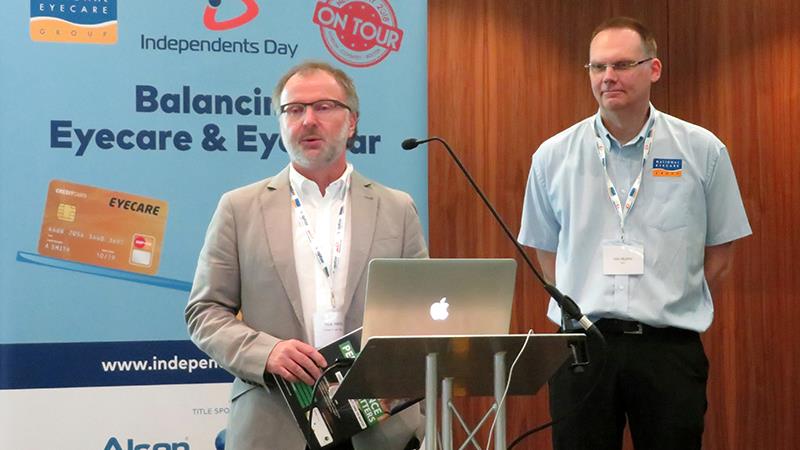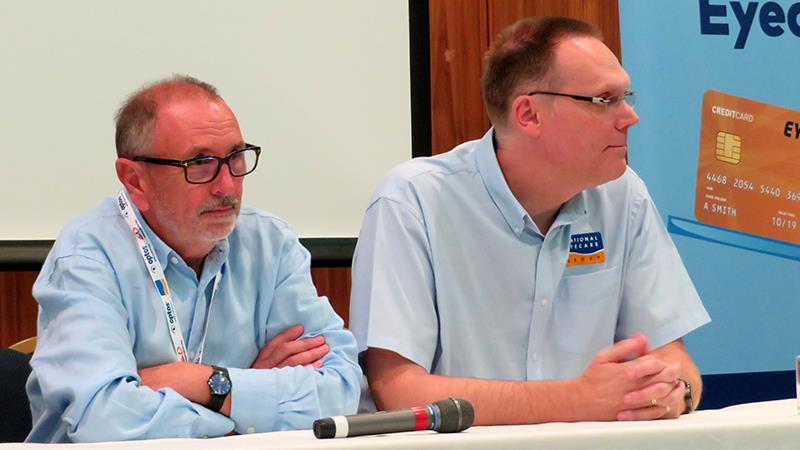This year’s Independents Day was, in fact, three Independents Days.
Under a new format, the one-day masterclass for independent practitioners kicked off in Wembley last month before exhibitors, speakers and an organising team including Proven Track Record and National Eyecare Group headed north to Coventry and then Bolton.
Lectures and CET workshops this year covered topics including practice refurbishments, provision of hearing care and myopia management.
Keynote speaker Andy Clark began proceedings in London by urging independents to ask themselves a series of questions about their identity and how they planned to get more patients to walk through the practice door.
The optometrist explained how a practice ‘archetype’ and patient ‘avatar’ system used by his Practice Building consultancy helped renew focus.
Practice archetypes were broken into price, retail and specialty categories, with tags including premium, boutique and value propositions. Local patient avatars might include ‘thrifty 30s’, ‘busy mums’ or ‘DINKYs’ (double income no kids), and practice owners encouraged to select who they wanted to work with most.
‘Be very careful about driving your average transaction value (ATV) to the point nobody can afford you,’ Clark said. ‘Find your opportunity.’
The Practice Building approach was endorsed by two individuals at Independents Day who delivered case studies – Gerard Fernandes from Lynne Fernandes Optometrists and Mark Holloway from Thomas & Holloway Opticians.
The Lynne Fernandes practice group had an ‘ordinary plus’ price archetype, with a convenient location offering clinical and dispensing specialisms. Fernandes said this archetype attracted patient avatars including DINKYs, glamorous grandparents and professional presbyopes.
Holloway, meanwhile, had spent ‘a small fortune’ in the past six to seven years updating the family business to tailor it for children, glamorous grandparents and presbyopia patients who often faced time pressures of their own, he explained.
‘Fashionable presbyopes don’t want to be coming back every five minutes for an adjustment,’ said Holloway.
Fernandes had also decided to embark on a practice re-fit that was completed this autumn, to improve upon ‘cluttered frame displays and an unattractive frontage’.
‘The way we thought of our refit was to think about where optometry will be in five years and where do we want to be in five years,’ said Fernandes.
Clark said the big lightbulb moment from his workshop sessions with delegates later on in the day was the realisation that, with the right tools, they can compete.

iDay organisers Nick Atkins and Phil Mullins
Also speaking at Independents Day was retail designer and owner of the Retail Experience Design agency, Dean Waugh. Having helped with numerous optical practice revamps, including Blackheath Eyecare Opticians and Aston & Woods, he said perceived value was the most important impact to get across to visitors.
‘From the moment people walk into a shop it is the perceived image that will hopefully drive sales,’ he said, urging high street practices to move away from the old-fashioned look of beech wood flooring, displays and counters.
‘A really big bugbear of mine is having up to 100 products on the frame bars and the frames all merging into one. We want the products to look as sexy and as inviting as they can as we are trying to create unique customer experiences,’ added Waugh.
‘The dispensing area is often quite unloved. It is a vital piece of the puzzle that is being missed out,’ added Waugh, who was an advocate of creating a side-by-side dispensing space instead of this happening across the table.
His other advice included hiding mess and paperwork from the reception area, and ensuring the practice name was the most prominent brand on display, rather than the best-known products in stock.
For independent practices looking to provide an entirely new service, Ryan Leighton, CEO and owner of Leightons Opticians & Hearing Care, introduced the Hearing Care Partnership in Wembley.
He told practitioners that one in six people in the UK have a form of hearing loss, representing 11 million people. In total, 1.6 million hearing aid units are dispensed each year, with one million of these supplied by the NHS. ‘The numbers are going to get increasingly big,’ said Leighton.
‘It’s about trying to put together clinical and quality in a way audiology hasn’t really managed to do yet in the UK. We have had a lot of independents coming to us and saying “can you develop a hearing care service for us”,’ he added
The Hearing Care Partnership is on course to reach 100 practices by the turn of the year.
Leighton said enrolled practices could look to gain profits of £25,000 per year with zero capital investment. This figure included share of revenue, total incentives, profit gain, retention profit value and optical gain from integrated marketing.
Leightons itself has sound-insulated rooms for the delivery of hearing care services in 20 of its 34 practices in the South East of England. But The Hearing Care Partnership was deliberately unbranded. Leighton said it entered an uncontested space for independents to concentrate on running their optical business but also provide audiology services for a number of days each week.

iDay roundtable duo David Goad and Phil Mullins
He made the case to independent practice owners that while adding an audiology service off their own back represented new revenue streams, the costs of marketing, training, salaries and back office support would likely result in net losses, even five years in.
The final session of Independents Day featured a panel discussion on the central theme of balancing eye care and eyewear.
Nick Atkins, managing director of Proven Track Record, said: ‘More eyewear at better value has got to be the way to go. I colour coordinate my spectacles so why wouldn’t I do that for my patients?’
Fellow panellist Phil Mullins, director of business development at National Eyecare Group, said: ‘If there is a big drive for high end then they might not be doing their homework. You need to think about where you want to be in five years’ time. Sometimes we get so worked up and say we are clinicians so we look after people’s eyes, but if your practice is going badly then you have to think again.’
Founding PTR partner David Goad encouraged delegates at Independents Day to use web marketing in the right way to emphasise what they were doing best on the high street. ‘But it’s no good portraying yourself in a fantastic way digitally if you don’t live up to it in your practice, or driving values up if the environment around you won’t sustain that,’ he said.
Meanwhile, the panel agreed the independent sector can withstand the threat of cheap online eye tests and optical products.
‘Anything that is a specialist service with a human being running it cannot be commoditised,’ said Clark. Mullins agreed saying high streets can pull people in merely for a shopping experience, while Goad said the practices who should really be worried about online were those offering free and £10 eye exams.
‘The best advice is to take time to work on your practice as well as in it,’ he added.
